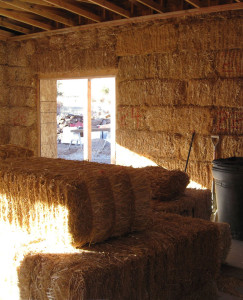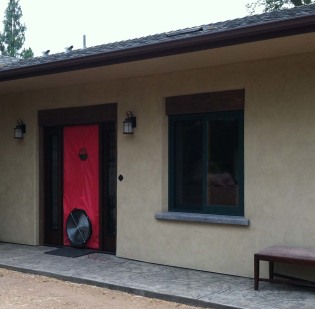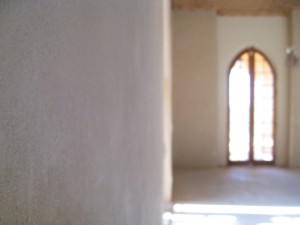
Although the distinguishing elements of strawbale building (bales and clay plaster) are natural and low-tech, it is a remarkably high-tech system. Strawbale building is the most resource-efficient way to build a superinsulated energy-efficient building.
Insulation is the key to energy-efficient buildings because it makes the most of the energy used to heat or cool the building. Insulation is measured in R-value, which rates a material’s resistance to heat flow (the higher the number, the higher the resistance). A well-built 2”x6” wood-framed wall is R-19. Strawbale wall assemblies have been tested and are generally accepted to be R-1.45 per inch. A typical 23″ thick strawbale wall would be R-33, though the CA Energy Commission rates a straw bale wall at R-30.
Less energy goes into building a strawbale building and less energy is require to run it. Strawbale buildings are two to three times more resistant to heat flow than conventional buildings. Other forms of superinsulation exist but require large amounts of high-embodied energy materials such (as foam or fiberglass) to achieve the same result. The embodied energy of straw is 1/4th that of the amount of fiberglass insulation needed to reach the same insulation value.

To achieve an insulation value of R30 without bales, either a double wall system or a foam based system would be required, both of which require much more energy and resources to construct.
Because the structural elements, such as posts, are on one side of the 18″ – 24″ thick straw bale wall, there is very little opportunity for thermal bridging which compromises most other insulation systems.
Straw is an annually renewed agricultural waste product: it is the by-product of the production of grain. Except for the energy used to bale the straw, all the energy used to create a straw bale was necessary for the production of food. Though there are some other uses for straw (animal bedding and erosion control) much more straw is produced than is needed. Until recently, farmers would burn the straw in the fields which produced significant air pollution.

Because plastered bales have little oxygen available for fire, straw bale buildings have a better fire-resistance rating than most conventional buildings (1 hr for clay-plastered, 2 hrs for lime-cement plastered). Plastered straw bales replace the insulation, drywall, paint, and some of the wood used in a conventional system. The plasters can be created with very low-embodied energy materials such as local clay soil mixed with leftover straw.
If attention is paid to the edges and few penetrations in a strawbale wall, they can be quite air tight. There is also no opportunity for air flow within the densely packed bales themselves and wet-applied plasters help seal potential air gaps. There are a growing number of Passive House certified strawbale homes that have achieved the strict Passive House airtightness rated of no more than 0.6 ACH50.
Clay plastered strawbale walls deal with indoor moisture well. The clay plaster has significant hygric mass which buffers changes in humidity by storing excess moisture when it is damp and then releasing it when the air becomes drier. Strawbale walls are vapor-permeable (as high as 15 perms) and do not trap water-vapor. The thickness of the strawbale wall creates a temperature gradient, reducing the potential for condensation points which can lead to mold.
Plastered strawbale walls provide good sound insulation (STC 50dB) and have been able to withstand winds in excess of 130 miles per hour. Strawbale buildings walls are more ductile and perform well in a seismic event. Anecdotal evidence from Israel tells us that strawbale walls can stop bullets from an AK47.
Interested in hearing more? We are available to present talks, lectures, and demonstrations to your school, church, or other groups. Content can be tailored to your group’s interest. Contact us for more information.
